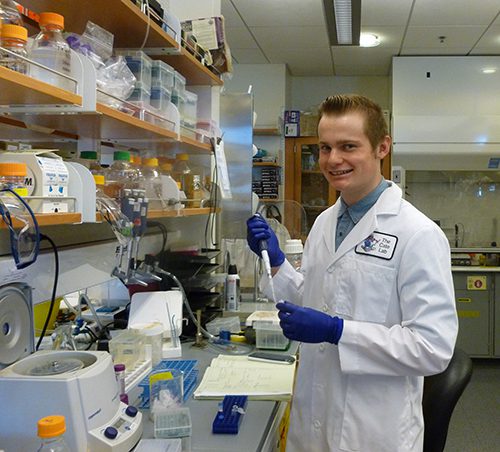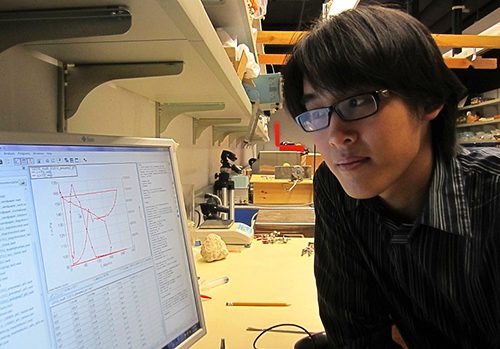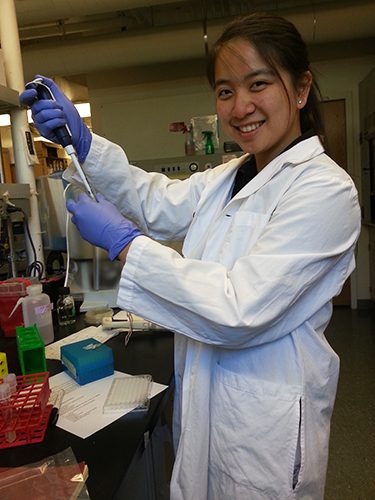Gregory Phillips

As nascent proteins are synthesized, specific polypeptide sequences can interact with the ribosome exit tunnel to arrest translation, effectively stalling the ribosome. Importantly, stalling is sometimes dependent on small molecules raising the possibility that drugs may be designed to inhibit the synthesis of specific proteins implicated in disease. My research aims to explore the question of how both the amino acid sequence of a nascent polypeptide and the presence of a small molecule interact with the ribosome to arrest elongation. Specifically, the Arginine Attenuator Peptide elicits elongation arrest in the […]
Ryan Rezvani

G-Protein coupled receptors (GPCRs for short) are a class of membrane proteins that bind to a specific chemical stimulus, an interaction which then initiates a cellular response pathway. Such a mechanism is present in most eukaryotic organisms, where it governs over processes like olfactory responses, neurochemical signal reception from chemical compounds, or the systematic release of hormones. The manipulation of GPCR-mediated pathways can allow for novel cellular responses to a ligand of choice, a phenomenon that can be expanded to the scale of a whole nervous system if implemented uniformly […]
Joshua Saul

Many organisms have the potential to regenerate damaged tissues; however, this potential decreases as the organism ages. Using the model organism Drosophila melanogaster, I will perform a screen to identify genes that are involved in up-regulating or down-regulating regeneration in damaged tissues as the organism ages. To conduct this screen, we have developed a new genetic ablation system that allows us to damage wing tissue in the developing fly at precise timings, as well as to express or knockdown any gene of interest in the damaged tissue. By scoring the […]
Camillia Azimi
In the Raulet lab, we are interested in studying the ability of a subset of innate lymphocytes called Natural Killer (NK) cells to respond to stimulation (responsiveness). NK cell responsiveness mainly depends on their ability to engage with a family of proteins called Major Histocompatability Complex Class I (MHC-I) molecules commonly expressed throughout the body. However, whether a particular cell type is responsible for setting the levels of NK cell responsiveness is still outstanding. During the summer, I will develop part of a bigger project aimed in identifying the cellular […]
Aaron Tran

We are conducting laboratory experiments to study bubble dynamics in natural mud sampled from mud volcanoes near the Salton Sea in Southern California. Gas bubbles bursting at the muds free surface exhibit unusual behavior: bubble films first rupture away from the bubble apex, and often rupture at multiple locations simultaneously. I will use a high-speed video camera to measure features of multiple bubble bursts, and a cone-plate rheometer to characterize the muds rheology. Based on the experimental observations, I will formulate a simple physical model that can be used to […]
Cameron Baradar
Quantitative portable medical diagnostics devices have the potential to transform medicine by providing a range of analytics that cannot be provided by classical binary readout assays. We are developing a next-generation portable clinical diagnostic device with low-power consumption that produces digitized data. To accomplish this we will utilize a detection method called, capacitively coupled contactless conductivity detection (C4D), with microfluidic electrophoresis for detection in a low-power compact cheap plastic microchip. C4D directly detects ions using two external electrodes via capacitive coupling between the electrode and the solution in the microchannel. […]
Helen Tran

Salmonella is a Gram-negative pathogenic bacterium that can invade cells, take residence within macrophages, and evade the immune response, causing illness and death especially in those with compromised immune systems. Recently we have discovered that Salmonella and E. coli release ATP to culture medium and we are currently determining the function and the mechanisms of ATP release. The initial plan for my summer project was to determine the role of ATP release in biofilm formation, which allows Salmonella to become more resistant to stressful conditions and antibiotics. After doing preliminary […]
Rebecca Trinh

Many animal behavior theories are based on honest communication and predict low levels of cheating and dishonesty. However, new studies are beginning to show that certain systems are prone to cheaters. This study will be among the first to focus on hermit crabs and their claw regeneration, and the potential dishonest message that claw may send. Male hermit crabs have a sexually dimorphic larger right claw used to fight and defend territories. When lost or damaged, hermit crabs are able to regenerate their claw, re-growing it to its original size […]
Surbhi Trivedi

The goal of this research project is to investigate the diversity profile of DENV populations within each human host (i.e., at the intrahost level). Previous studies on DENV-2 diversity from the Harris Lab have identified significant levels of variation in genomic diversity between genes, notably in the Envelope gene, which encodes for a viral structural protein that is an important target for antibody binding. Our research aims to compare DENV diversity profiles by harnessing high-throughput deep sequencing technology to sequence viral populations in individuals with primary and secondary DENV serotype […]
April Choi

Nor-1 is a protein that can promote death of CD4+ CD8+ double positive thymocytes, cells in the process of maturing into T cells. In the thymus, these double positive thymocytes undergo a process called negative selection, in which any thymocytes that recognize self-molecules that our own body produces are killed. This makes sure that our body mounts an immune response when it encounters a foreign pathogen. Failure during this negative process results in autoimmune diseases such as systemic lupus erythematosus (the go-to disease whenever someone is sick in the episodes […]